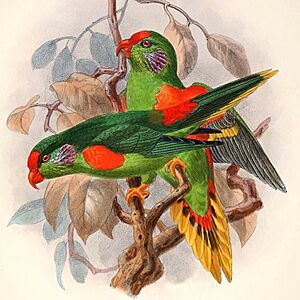Red-fronted lorikeet facts for kids
Quick facts for kids Red-fronted lorikeet |
|
|---|---|
 |
|
| Conservation status | |
| Scientific classification | |
| Genus: |
Hypocharmosyna
|
| Species: |
rubronotata
|
| Synonyms | |
|
Glossopsitta rubronotata (Wallace, 1862) Coriphilus rubronotatus (Wallace, 1862) |
|
The red-fronted lorikeet (Hypocharmosyna rubronotata) is a small, colorful parrot. It is also known as the red-spotted lorikeet or red-rumped lorikeet. This bird belongs to the Psittaculidae family, which includes many types of parrots.
You can find the red-fronted lorikeet in northern New Guinea and on the island of Biak. It lives in warm, wet montane forests, which are forests found in mountainous areas.
Contents
About the Red-Fronted Lorikeet
This bird was once placed in a different group of parrots called Charmosyna. However, after scientists studied its DNA in 2020, they moved it to a group called Hypocharmosyna. This group was used before and has now been brought back.
There are two main types, or subspecies, of the red-fronted lorikeet:
- H. r. rubronotata (Wallace, 1862) – This type is found on Salawati island, the West Papuan Islands, and across New Guinea.
- H. r. kordoana (Meyer, AB, 1874) – This type lives on Biak island, in Geelvink Bay, and in Irian Jaya.
What Does a Red-Fronted Lorikeet Look Like?
The red-fronted lorikeet is about 17 cm (6.7 in) (7 inches) long. It weighs around 30–35 g (1.1–1.2 oz) (1 to 1.2 ounces), which is about the weight of a few coins.
Males and females of this species look quite different. This is called Sexual dimorphism.
- Males of the rubronotata type have a red forehead and a red beak. Their eyes are orange. They have purple or blue feathers near their ears, with lighter blue streaks. The feathers under their wings are red. Their green tail has a yellow tip, and the base of the side tail feathers is red.
- Females have a green forehead and green feathers near their ears, with green or yellow streaks. The feathers under their wings are green. They also have red marks on the feathers above their tail.
The males of the kordoana type usually have a larger, but paler, red forehead. Their ear feathers are more bluish than purple. The females of kordoana look the same as the rubronotata females.
Young lorikeets look like adult females. However, young males also have red feathers under their wings and dark, plain ear feathers. They have a yellow band under their wings. Their beaks are brown, and their eyes are light brown.
These birds make soft, harsh sounds when they fly. They also make sharp "kss" notes.
Where Do Red-Fronted Lorikeets Live?
The red-fronted lorikeet lives in northern New Guinea and on the island of Biak. You can find them in humid forests, at the edges of forests, and even in coconut farms. Sometimes, they are seen in trees and bushes in open areas. They live at elevations up to 900 m (3,000 ft) (about 3,000 feet) above sea level.
How Red-Fronted Lorikeets Live
These small parrots are often seen in small groups, sometimes up to 10 birds. They fly above the forest canopy. They also like to feed with other types of lorikeets. They often gather to eat flowers high up in the trees.
Reproduction and Life Cycle
The breeding season for red-fronted lorikeets is usually in July and August. Females lay two eggs at a time. Each egg is about 17.0 mm × 13.5 mm (0.67 in × 0.53 in) (0.67 x 0.53 inches) in size.
The eggs hatch after about 23 days. The baby birds, called chicks, are ready to fly from the nest (fledge) when they are about 7 weeks old.
What Do Red-Fronted Lorikeets Eat?
Red-fronted lorikeets enjoy a diet of pollen, nectar, flowers, and seeds. They use their special brush-tipped tongues to collect nectar from flowers.
Red-Fronted Lorikeets and People
These colorful parrots are not very common as pets.
Protecting Red-Fronted Lorikeets
The red-fronted lorikeet is listed as a species of "least concern" by conservation groups. This means their population seems to be stable and not currently at risk. They are also listed under CITES II, which means their trade is controlled to prevent them from becoming endangered.


